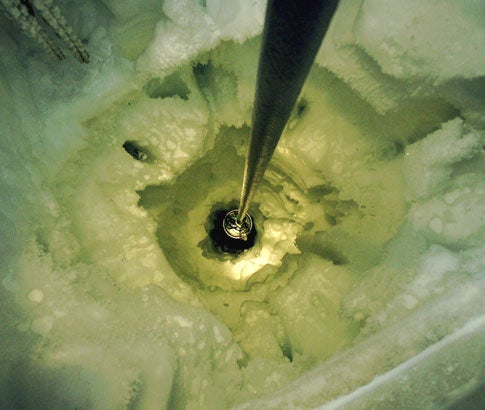The neutrino observatory IceCube has moved closer to completion and is on track to start data collection next year. IceCube is located at the South Pole, in clear Antarctic ice. When completed, it will have 4,200 sensors — 60 optical sensors on each of 70 lines — frozen into a cubic kilometer of ice. In addition to these underground sensors, IceCube will have roughly 300 sensors on the surface. IceCube will be the world’s largest detector.
An international team of scientists, led by the University of Wisconsin, Madison’s Francis Halzen, is building IceCube around an older neutrino telescope, AMANDA. During this past austral summer — October 2005 through February 2006 — the IceCube team was able to install eight strands of 60 detectors, for a total of 480 detectors. Combined with the strands already in place because of AMANDA, IceCube now has roughly 1,300 detectors.
Each of the eight recently installed strands sits in a 1.5-miles-deep (2.4 kilometers) hole, which the team made using a sophisticated hot-water drill. Scientists can work on the detector only during the South Pole’s summer, when temperatures average between -35° and -16° Fahrenheit (-37° and -27° Celsius).
Scientists successfully installed the first string of IceCube sensors in January 2005. These detectors are functioning beautifully, which is good news for the science team. Given the installation’s progress, the team feels confident that IceCube will be completed by the anticipated start of 2011.
IceCube will study cosmic neutrinos in the Northern Hemisphere sky using Earth as a filter for unwanted particles (namely solar neutrinos and subatomic particles called muons from sources other than neutrino interactions). The detectors are basketball size and have electronics to detect light and process data. When a cosmic neutrino rams into a proton or other particle in the ice, the interaction emits a muon. This muon then will emit a light cone — known as Cerenkov radiation. The detectors will sense the light, showing the light’s track. From this, scientists can determine the incoming neutrino’s path and energy.
Neutrinos have no electric charge and interact weakly with matter, so they can travel cosmological distances without deflection. Because of this, neutrinos hold secrets of the universe’s most energetic events, including supernovae and gamma-ray bursts.










